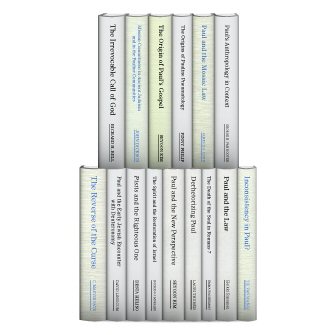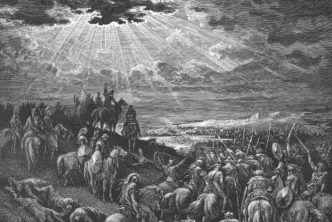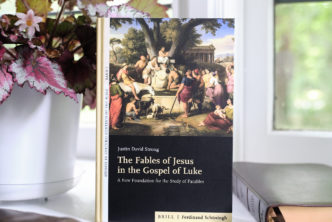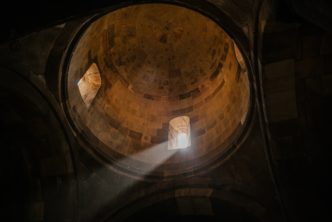
The Mohr Siebeck Interviews are a chance to hear from some of the most influential authors in Pauline studies of the past few decades. In this short series, we will be hearing from a number of outstanding scholars, including Marvin Pate, Seyoon Kim, and Jimmy Dunn.
 For our second interview, I had the opportunity to chat with Seyoon Kim on his book, Paul and the New Perspective: Second Thoughts on the Origin of Paul’s Gospel, published originally with Mohr Siebeck in 2002, and part of the 15-volume Mohr Siebeck Perspectives on Paul, Judaism, and the Law, now in pre-publication for the Logos library.
For our second interview, I had the opportunity to chat with Seyoon Kim on his book, Paul and the New Perspective: Second Thoughts on the Origin of Paul’s Gospel, published originally with Mohr Siebeck in 2002, and part of the 15-volume Mohr Siebeck Perspectives on Paul, Judaism, and the Law, now in pre-publication for the Logos library.
Seyoon Kim is associate dean for the Korean Doctor of Ministry program and professor of New Testament at Fuller Theological Seminary.
1. What led you into biblical studies, and in particular, Pauline studies, in the first place?
When I embarked on my post-graduate theological studies, I was aspiring to become a systematic theologian. During the first year of preparatory reading for it, I realized that to become a good systematician, I had to be well grounded on biblical foundation. So I decided to do my doctoral work in biblical studies, and chose Pauline studies, thinking that it would prepare me the best for my eventual systematic theological work (but I have not been able to “advance” to it!)
2. What was the impetus behind writing Paul and the New Perspective: Second Thoughts on the Origin of Paul’s Gospel, and how does it connect to your previous and following research efforts?
The impetus was, of course, the critical debate on “the New Perspective on Paul” that had been dominating Pauline scholarship for over twenty years by then. There was also a personal component in it, as I had to respond to James D. G. Dunn’s severe criticism of the thesis that I had propounded in my dissertation (The Origin of Paul’s Gospel [Mohr Siebeck, 1981, 1984; Eerdmans, 1982]), that Paul’s gospel (especially his unique “image of God”/Adam-Christology and justification-soteriology) originated from the revelation of the exalted Christ at his conversion/call on the Damascus Road. When in his essay, “‘A Light to the Gentiles,’ or ‘The End of the Law’? The Significance of the Damascus Road Christophany for Paul” (originally 1987; then, reprinted in his Jesus, Paul and the Law [Louisville: Westminster/John Knox, 1990), Dunn published the criticism with the argument that the Damascus Christophany was significant as the event of Paul’s apostolic call to the gentiles rather than a revelation of the gospel of justification by grace and through faith (NB: the conjunction “or” in the title of his essay), I was teaching in Korea, and the difficult conditions there prevented me from responding to it for a long time.
Then, having moved to Fuller Theological Seminary at Pasadena, U. S. A., I was able to make my belated response. So, in the first and longest chapter of Paul and the New Perspective: Second Thoughts on the Origin of Paul’s Gospel, I defend my thesis that the gospel of justification originated from the Damascus Christophany along with the apostolic call for the Gentiles, in criticism of Dunn’s late dating of the origin of the justification doctrine to the Antiochian controversy as well as other features of his “New Perspective.” In chapter 4 I further support the thesis with more wide-ranging arguments and in criticism of Dunn’s exegesis of the crucial text Galatians 3:10-14 and the New Perspective’s neglect of the juridical meaning of justification in favor of its missiological and ecclesiological meaning. And in chapter 5 I try to confirm my thesis on the origin of Paul’s conceptions of Christ as “the image of God” and “Last Adam” from the Damascus Christophany with further arguments, noting also the strange and ironical fact of Dunn’s eventual acceptance of my thesis (without a proper acknowledgement) after such a harsh criticism of it!
Most of the other essays (chs. 2, 3, 6, 7) in Paul and the New Perspective are also concerned with developing further the theses that I advanced on Paul’s gospel and gentile apostleship in my dissertation. However, the last chapter (8), which is a reprint from The Dictionary of Paul and His Letters (Downers Grove: IVP, 1993), deals with Paul’s use and reflection of Jesus tradition. That study has led me to make the “Jesus–Paul” question almost my second “major,” and together with my former study on Jesus’ Son of Man sayings in the Gospels (The “Son of Man” as the Son of God [Mohr Siebeck, 1983; Eerdmans, 1985]), it also led me to see “the ‘Son of Man’ Christology hidden” in Pauline Christology (see ch 5 of Paul and the New Perspective, 194-208). A consequence of this new recognition of the importance of Jesus tradition for Paul was for me to modify my original thesis: Paul’s gospel originated not only from the Damascus Christophany, but also from Jesus tradition. I also reformulated my thesis: it was born of two parents—the Damascus Christophany as the father and Jesus tradition as the mother.
Both my interest in Paul’s gospel of justification that started with my dissertation and became intensified with the debate on the New Perspective and my appreciation of Jesus tradition in Paul are reflected in the commentary that I am writing on 1 and 2 Thessalonians (Word Biblical Commentary Series). They have also shaped a short book that I have just written, Paul’s Gospel of Justification and Jesus’ Gospel of God’s Kingdom, which I am going to send to a publisher shortly.
3. How do you feel your book has helped direct the discussion of Paul since its publication, and is there anything you wish you had done differently or emphasized more?
I don’t think that this book has made much impact on Pauline studies, certainly not as much as my first book, The Origin of Paul’s Gospel. It has been seen just as one of the many works that appeared during the last decades of the twentieth century and the first decade of the twenty-first century that were critical of the New Perspective. The combined efforts of those books may have helped some advocates of the New Perspective to modify their original views and make efforts to integrate their insights within the framework of the doctrine of justification fundamentally as a juridical soteriological doctrine, i.e., what they have labeled as “Old Perspective.”
Since I have challenged Dunn, especially on his understanding of the origin of the justification doctrine, asking him what gospel he thinks Paul preached during some 15 years between his apostolic conversion/call on the Damascus road and the Antiochian controversy, I am naturally glad that he has come to state clearly that from the beginning of his Christian life and apostolic career Paul was clear about justification being by God’s grace and through our faith. But still, he insists that Paul’s formulation, “justification by grace and through faith without works of the law,” came about only in the wake of the Jerusalem Council and the Antiochian controversy. This appears to me very arbitrary and unrealistic, given the fact that Paul, the trained Jewish theologian super-zealous for the law, was converted and became an apostle to the gentiles long before those two events. In their scholarly works, both Dunn and N. T. Wright have appreciated the importance of Jesus tradition in Paul, of course, quite apart from my work; nevertheless, it is still gratifying to find Wright recognizing the value of my essay that is reprinted as chapter 8 of this book (see his Paul and the Faithfulness of God, 1104, n. 255).
I have been criticized very much for being too harshly polemical, especially with Dunn. The criticism is a just one, and I have regretted it much.
4. Tell us a bit about the writing process, and how that impacted the final product (for example, was this done in one long sabbatical, or achieved in 15-minute slots of time between classes, etc?).
The essays that form chapters 6, 7, and 8 were reprints of my earlier contributions respectively to a collection of essays, a journal, and a Bible dictionary. Chapters 3–5 were written during the summer vacation and the ensuing sabbatical quarter in Fall 1999, which I spent at Tübingen with the generous support of Alexander von Humboldt Foundation, Bonn, Germany (their “Wideraufnahme” Program). Finally, chapters 1–2 were written, often between classes, during 2000.
5. How would you describe the process of publishing with Mohr Siebeck?
It was a great honor for me to have three books published in the most prestigious series WUNT (Wissenschaftliche Untersuchungen zum Neuen Testament) at the most respected publishing house, Mohr Siebeck. The books that the House has published, both through their scholarly quality and the quality of their printing and binding, eloquently testify that, at least in our biblical and theological field, Mohr Siebeck has excellence that is beyond comparison. The friendliness, thoroughness, and efficiency of the staff at the House also do not need an elaboration.
6. Where do you see the future of Pauline studies going after the New Perspective (and perhaps after the so-called Radical New Perspective)? Will there be a rebound to the Old, an integration or sorts, or something else entirely?
I think that the gap between the Old and New Perspectives has narrowed considerably. Some advocates of the former now recognize that Judaism was a covenantal nomism in its fundamental structure, in spite of the individualistic idea of earning merit through faithful observance of the law that developed within it, especially with the last judgment in view. Some also appreciate the importance of the missiological and ecclesiological corollary of Paul’s justification doctrine, while some advocates of the New Perspective acknowledge their undue neglect of the fundamental juridical soteriological meaning of that doctrine and recognize the need to integrate the strengths of the two perspectives (cf. esp. N. T. Wright’s works that seek to chart out a new comprehensive perspective, integrating even the political dimension of Paul’s gospel).
In his recent work, Paul and the Gift, J. M. G. Barclay has subjected both perspectives to a critical scrutiny and questioned the usefulness of the notion of “covenantal nomism” for defining Judaism and the propriety of the understanding of “grace” by the advocates of both perspectives. Barclay’s work is an example of breaking free of the mold of the debate between the two perspectives that has dominated New Testament scholarship during last 40 years. With my new book, Paul’s Gospel of Justification and Jesus’ Gospel of God’s Kingdom, I also attempt to do it by approaching the doctrine of justification from the combined perspective of Christology and anthropology. There I try to show how both the Old and the New Perspectives fail to explain properly the relationship between the indicative of justification and the imperative of ethic, as well as that between the doctrines of justification by grace and judgment according to works. They both approach the questions only anthropologically or anthropocentrically and not also Christologically, or from the perspective of the kingdom of God and his Son, Jesus the Lord. I try to show that Barclay’s approach through the “anthropology of grace-gift” alone is no exception to this.
A by-product of my study is to ascertain that the New Perspective has not wrought quite a Copernician revolution to understanding of Pauline gospel, as it appeared promising at least to some during the early days of its movement. Rather, it has made only a contribution, albeit a significant one, to a more comprehensive and contextualized understanding of Paul’s gospel by highlighting its missiological and ecclesiological dimensions that had been neglected in the traditional exposition.
With the insights, both positive and negative, gained from the 40-year “Old and New Perspective debate,” but freed from its mold, future New Testament scholarship may yet propose a fresh new approach for a better and more relevant understanding of the gospel that the apostle Paul preached two thousand years ago, bringing about a religious and socio-cultural revolution to the ancient world—as Martin Luther did with his new interpretation, bringing about a religious and socio-cultural-political revolution to the Medieval era 500 years ago.
 Seyoon Kim’s Paul and the New Perspective: Second Thoughts on the Origin of Paul’s Gospel is currently in pre-production along with the 15-volume Mohr Siebeck Perspectives on Paul, Judaism, and the Law. This means you can get exceptional early-bird pricing if you order now, especially during the Logos Christmas discount during the month of December.
Seyoon Kim’s Paul and the New Perspective: Second Thoughts on the Origin of Paul’s Gospel is currently in pre-production along with the 15-volume Mohr Siebeck Perspectives on Paul, Judaism, and the Law. This means you can get exceptional early-bird pricing if you order now, especially during the Logos Christmas discount during the month of December.
When you do the math, the 15-volume set comes out to just over $16 per volume. This is a truly incredible price for a Mohr Siebeck monograph of any size.




Hi,
I might have missed it but when will Dr Kim’s latest book be available?
Thanks,
ES